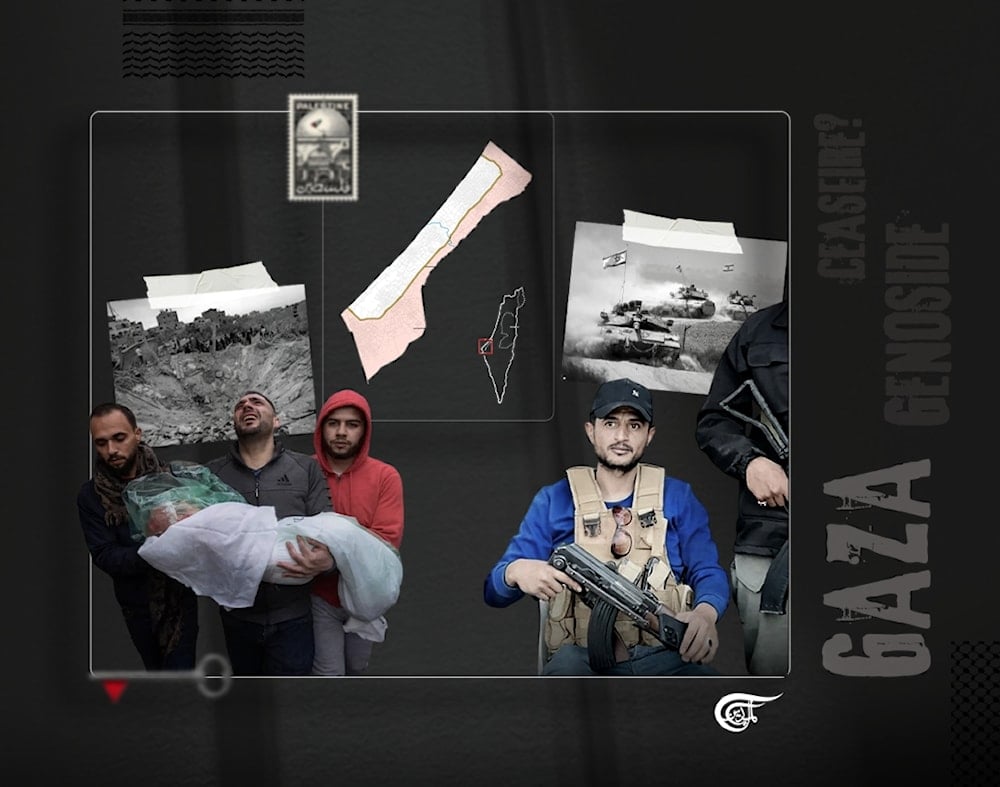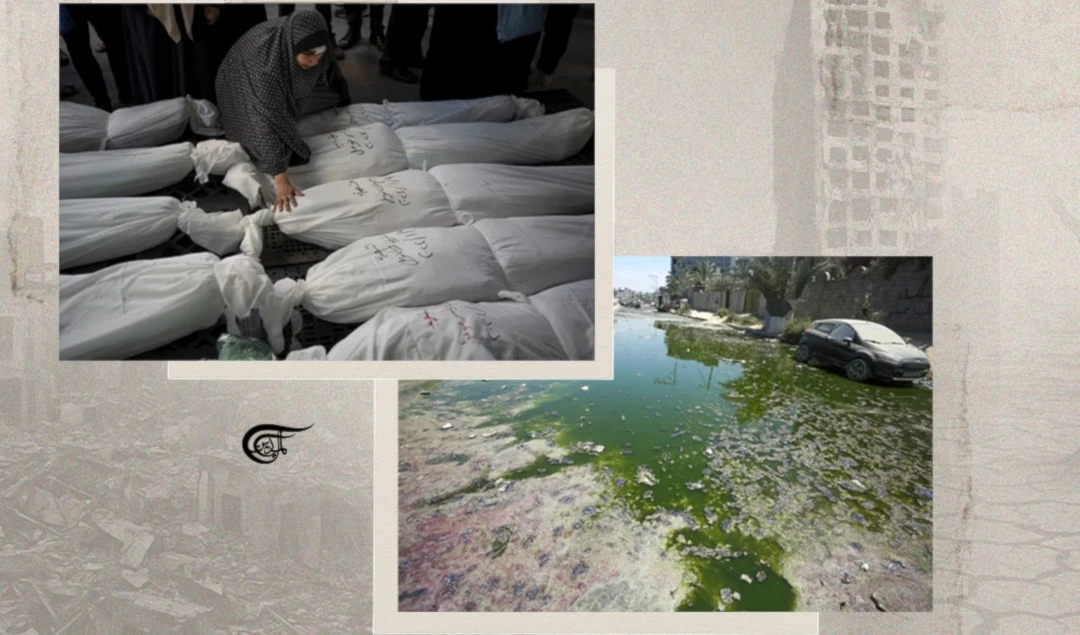What is the Israeli strategy in Gaza?
Robert Inlakesh argues that "Israel", with US backing, is using the ceasefire to advance a longer-term strategy in Gaza: fragment the enclave, empower proxy collaborators behind a partial occupation line, strangle civilian life in Hamas-administered areas, and prepare to resume full-scale force if those aims fail.
-

In the Zionist regime’s thinking, now is a historic opportunity to exterminate all those who resist it, eliminate Gaza entirely, and impose uncontested dominance over the region. (Al Mayadeen English; Illustrated by Batoul Chamas)
In order to understand the Israeli-US agenda underlying the so-called “peace plan” set forth by US President Donald Trump, it is important to examine the objectives of the Zionist regime and then assess how these aims might be realized. Such an analysis helps reveal what the future may hold and whether the fragile ceasefire is likely to endure.
On October 19, the Gaza ceasefire appeared to have collapsed after the Zionist regime launched over 100 airstrikes, dropping at least 153 tonnes of explosives across the besieged coastal enclave, and killing around 44 civilians. Even Israeli media outlets reported that the ceasefire had broken down and that the war had re-started, before the situation calmed down by the next day.
Initially, the Israeli establishment claimed that two of its soldiers had been killed by Palestinian fighters in an ambush involving RPGs and automatic weapons, asserting that its subsequent attacks were merely a response to this incident—one that Hamas categorically denied any involvement in.
Yet, it wasn’t long until American, Palestinian and even Israeli reporters began to reveal the truth. In reality, while Israeli soldiers, alongside settlers contracted for demolition work, were violating the ceasefire by destroying Palestinian infrastructure, they accidentally drove over an unexploded ordnance. The consistency of reports from multiple sources lent credibility to this account, yet the Zionist military quickly imposed a publication ban on the incident, before later partially admitting to what had truly occurred.
This meant that the Israelis had, in essence, killed their own soldiers by violating the ceasefire and sending their forces to destroy infrastructure within what was effectively an active minefield, then blaming the Palestinians as a pretext to kill more civilians. Up until that point, the Israelis had already committed at least 80 ceasefire violations and killed more than 100 innocent people.
From day one of the ceasefire, the Israelis had also adopted a strategy of outsourcing the Gaza front’s combat operations to three ISIS-linked proxy militias - each stationed in different areas behind the Israeli imposed ‘Yellow Line’ – instead of engaging Hamas directly. The Zionist regime began pursuing a policy of using these proxy forces to carry out assassinations and ambushes against prominent figures and members of Gaza’s security apparatus.
The Israeli strategy, backed by the United States – according to anonymous sources who spoke to Axios – is to begin using reconstruction funds, to build structures behind the Yellow Line, which represents around 54-58% of Gaza’s territory where the occupation refuses to withdraw and works alongside its proxies to control the enclave. At the same time, the Israelis sought to strangle the civilian population living in areas under the Hamas-led civil authority, while offering them the alternative of living under the joint Israeli-collaborator occupation.
This strategy has already begun to crumble, as many of the families which the Zionist Entity sought to co-opt have sided with the resistance and rejected the collaborators in the midst. Meanwhile, the Palestinian Resistance continues to pursue these collaborator death squads and prosecutes them for their various crimes, including acts like murder and aid theft.
Like other similar strategies proposed by the Israeli regime and greenlit by their subservient American backers, this one is likely to fail under pressure and does not make logical sense given the realities on the ground and the fact that the Zionist proxies have no popular support.
So, then, what do the US-Israeli alliance have in store? It is quite simple, they are seeking to achieve some of their goals under the guise of a ceasefire, which they only partially respect by allowing in limited aid supplies and killing less people than they did prior to the so-called “peace deal”.
Similarly, in Southern Lebanon, the Israelis hatched a scheme after the ceasefire was imposed to seize control of more territory than they managed to capture during the war, all while committing daily ceasefire violations. carefully calibrated to stop short of triggering a return to an all-out war.
If they fail to achieve their aims through limited military measures and aggressive maneuvers dressed up as diplomacy, they will resort to full-scale force, because “peace” is not an option.
In order to understand this line of thinking, you first must conclude that the Israelis have pursued their policies up until this point as a means of collapsing the regional resistance against them, eliminating each and every threat posed to their rule.
To the Zionist regime, there is a perceived imperative to produce an “answer to the Gaza question”, a formulation that, in their view, amounts to the elimination of the people of Gaza: an ethnic cleansing campaign and genocide accompanied by the destruction of the entire territory’s infrastructure. This is not only the objective of the Israeli leadership, but a project implicating Israeli society as a whole, a national project of elimination.
October 7, 2023, represented a major blow to the Zionist project, one that collapsed the illusion of its military superiority and shook its ideology to the core. So, it has since pursued a project to teach its adversaries a lesson and to destroy the ability of regional actors to resist them. Gaza is a statement, rise up against us, and we will pulverize you.
To a certain extent, this strategy has so far succeeded to deter any Arab population from rising up. Immediately after October 7, the Jordanians and Egyptians, for example, had started to join mass demonstrations, attempted to breach the border, and clashed with regime forces. Yet the daily scenes of devastation in Gaza, along with the propaganda pushed by the Arab Regimes, crushed their pride, determination, and willingness to continue resisting, at least for now.
The regional resistance, however, remained undeterred, which is why the US-Israeli alliance now seeks to destroy it, or at least to weaken it so severely that it no longer poses a significant threat.
If the Israelis experience another October 7-style military defeat that includes the penetration of its defensive lines, this will represent a decisive, even mortal, blow to the project, and the Zionist regime is well aware of that.
What occurred on October 7 irrevocably transformed the regime and set in motion a series of irreversible changes. Senior Zionist leaders now view current events in stark binary terms: either the re-birth of “Israel” or its gradual demise. If the former is achieved, the regime would secure de-facto control over the region and bury its security issues; if it fails to eliminate Gaza, to break the Lebanese resistance, and to sufficiently weaken Iran, it will be one step away from a crushing defeat.
In the Zionist regime’s thinking, now is a historic opportunity to exterminate all those who resist it, eliminate Gaza entirely, and impose uncontested dominance over the region. Although it has so far failed to achieve these goals, it perceives any inability to secure a “total defeat” as an existential threat to its own survival. Therefore, if "Israel" does not accomplish during the ceasefire what it set out to do, it is likely to pursue those objectives through renewed military action, with Lebanon and Iran expected to become the principal fronts in the future.

 Robert Inlakesh
Robert Inlakesh
 7 Min Read
7 Min Read











